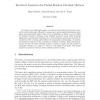Free Online Productivity Tools
i2Speak
i2Symbol
i2OCR
iTex2Img
iWeb2Print
iWeb2Shot
i2Type
iPdf2Split
iPdf2Merge
i2Bopomofo
i2Arabic
i2Style
i2Image
i2PDF
iLatex2Rtf
Sci2ools
CORR
2010
Springer
2010
Springer
Restricted Isometries for Partial Random Circulant Matrices
In the theory of compressed sensing, restricted isometry analysis has become a standard tool for studying how efficiently a measurement matrix acquires information about sparse and compressible signals. Many recovery algorithms are known to succeed when the restricted isometry constants of the sampling matrix are small. Many potential applications of compressed sensing involve a data-acquisition process that proceeds by convolution with a random pulse followed by (nonrandom) subsampling. At present, the theoretical analysis of this measurement technique is lacking. This paper demonstrates that the sth order restricted isometry constant is small when the number m of samples satisfies m (s log n)3/2 , where n is the length of the pulse. This bound improves on previous estimates, which exhibit quadratic scaling.
Related Content
| Added | 09 Dec 2010 |
| Updated | 09 Dec 2010 |
| Type | Journal |
| Year | 2010 |
| Where | CORR |
| Authors | Holger Rauhut, Justin K. Romberg, Joel A. Tropp |
Comments (0)

